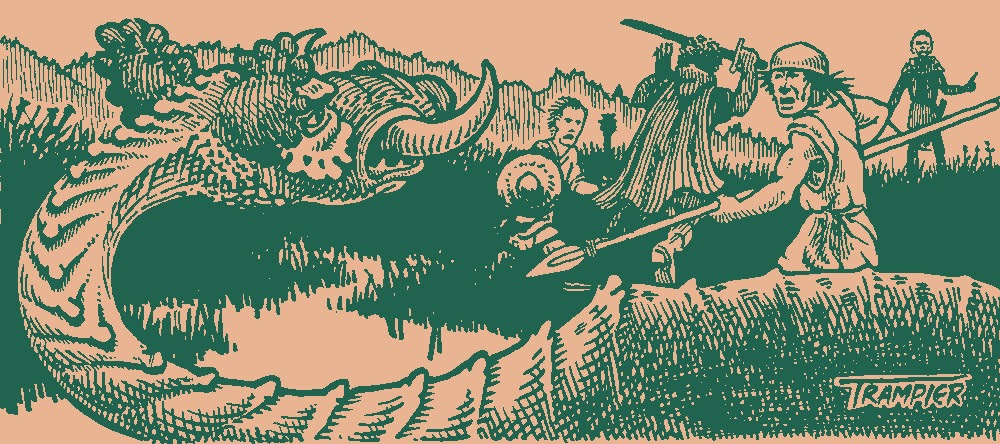borringman
Explorer
Fair. I ain't saying it's the way it should be, just how it be.I kinda hate everything about the attitude you describe. Build culture is what is "unfun" to my mind.
Fair. I ain't saying it's the way it should be, just how it be.I kinda hate everything about the attitude you describe. Build culture is what is "unfun" to my mind.
In your drive-by sniping, did you happen to read what that was a reply to?It works fine if you don't ignore those other things too. There's just more going on. Assuming that it doesn't is just projecting your preferences on others.
All the game world is just a dungeon. The only thing that changes is the scale...Do you agree? What are your thoughts on dungeon crawling versus rules complexity?
Wow, you didn't just move the goal posts, you went to another stadium.I disagree with this. I think you measure the "weight" of the game by the core components that aren't presented as optional.
(For the record, I agree that all game rules are, in reality, optional if you are brave enough, but I am talking about what the game tells you is core versus optional.)
Returning to this, because I had sort of glossed over these examples due to being unfamiliar with them.I ran Abomination vaults for a little bit as a method to learn PF2E, and found that the the complex rules made dungeon delving a chore. I ran and played in a 5E Rappan Athuk game with similar results, plus incongruities of matching that system to old school sensibilities. There were other attempts at dungeon crawling with PF1 and 3.x era D&D, all failures to some degree or another.
Upon discovering 5 Torches Deep, Shadowdark and other rules light D&D inspired games, i have come to the conclusion that dungeon crawling requires a rules light approach in order to be fun. Unwieldy, complex systems are slow, and turn the crawl into a grind. The juice isn't worth the squeeze, as the saying goes.
Do you agree? What are your thoughts on dungeon crawling versus rules complexity?
I was about to post the same - but got ninja'd in the darkness!Of course you need light rules for dungeon crawling. Otherwise, how do you know when the torches run out?
Outside of maybe my first 1-2 sessions where everyone at the table was learning the rules, I've not had this happen at all in pathfinder during exploration. The rules are very simple, straightforward, and easy to apply. It takes maybe 20 seconds to look something up and resolve as needed.When I talk about "grind" it isn't an issue of monotony so much as it is an issue of things coming to a near halt due to rules interactions
Ah, I get you. There are definitely varying slot systems, so their complexity can vary, and to be fair I mentioned a couple of different types.that is what i was suggesting, just with your number of slots being derived by your strength, (51 points/slots of carrying capacity), i was interpreting your suggestion of slots being more like 'this is your headwear slot, this is your chest slot, your beltpouch slots...', previously mentioned heavy/moderate/light/trinket designations being labels for standard weight point values
Expanding on this for anyone who hasn't seen it, I think Gus L has some excellent expanded thoughts on those two OSR maxims (and a few others).A couple principles for OS (especially dungeon) play from the Old School Primer
• Rulings, not Rules
• Player Skill, not Character Abilities
The reason, I think, that basic dnd became the lingua franca of the OSR is not only compatibility with old modules, but because it allows for the above principles in gameplay. That is, it's not about the amount of rules, but a stance toward the rules, which is to subordinate them to GM rulings, especially for the sake of quick play. Rules lite games, that is, games that don't have that many rules to begin with, just more easily facilitate this kind of approach to the game. Modern OSR games would take this further and simplify even more (compared to B/X). The core resolution mechanics of Into the Odd, Knave, The Black Hack, etc are very simple and could be fit onto a page.

It also achieves that page count by only having a couple of pages of monster descriptions and rules, only two pages of spell descriptions, and zero magic items. OTOH that page count also includes some full page art, an optional system for designing dungeons using a Rubik's cube, and quick reference pages.Five Torches Deep, based on reviews I've seen, only manages to slim the core book down to 46 pages by almost purely piggybacking off of the existing rules of 5e, which is in no way a "rules-light" game.
Modos RPG fits @Neonchameleon 's rules-light criteria. To address the no-tables-during-play criterion: the game has one table. It's a series of recommended benchmarks for Difficulty, what the GM uses to adjust roll results. So, PCs don't even need it. And it's small - about 2x6.I never understood this take. Even the one-side-of-one-page Lasers & Feelings has multiple lookup tables, and is a bit much for me to memorize in one go. I'm no one's idea of a smart person, but I'm struggling to visualize a system that meets this standard that isn't just a coin-flipping contest.
